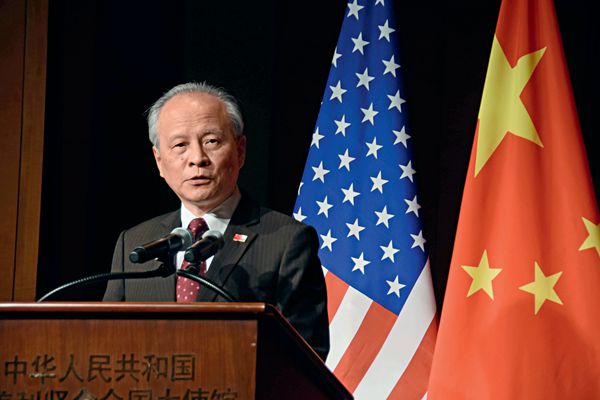New Model of Major-Country Relations to Enhance Joint Sino-U.S. Development
China Today by CHENG HONGLIANG, January 22, 2017 Adjust font size:
Leading Role of Diversified Mechanisms
Against this complicated backdrop, bilateral exchange mechanisms, including meetings between heads of state, are integral to guiding the appropriate development of Sino-U.S. relations.
Since the two countries first established diplomatic ties in the 1970s, almost 100 bilateral exchange mechanisms have been set up in diverse forms. They include meetings and hotlines linking top leaders, the U.S.-China S&ED, the China-U.S. High-Level Consultation on People-to-People Exchange (CPE), and the China-U.S. Joint Commission on Commerce and Trade, among many others.
The people involved range from heads of state to departmental directors. The areas covered include politics, economy, foreign affairs, military affairs, and law enforcement from the governmental to everyday level.
Among these mechanisms, meetings of heads of state have led the way. Looking back on the volatility of bilateral ties over the last few years, whenever the relationship met tough challenges, meetings between the top leaders steered it in the right direction.
Last year, the presidents of the two nations met on the occasions of the Fourth Nuclear Security Summit in Washington, the G20 Hangzhou Summit, and the 24th APEC Economic Leaders’ Meeting in Peru. In all three instances they agreed to constructively manage disputes and proactively carry out cooperation. Such talks between the two heads have propelled steady and healthy growth of bilateral relations.
The S&ED and CPE – the largest communication mechanisms in China-U.S. relations – play key roles in political mutual trust, economic and trade cooperation, and people-to-people exchanges. More than 300 results in strategic, economic, and cultural sectors were achieved last June at the Eighth Session of S&ED and the Seventh Session of CPE, held in Beijing. John Kerry confirmed that these were the most fruitful sessions he had ever attended. For the Chinese side, the results embodied the steady growth of bilateral relations.
Cooperation in Diverse Sectors
Although the two powers are inherently competitive in certain fields, this does not hinder their cooperation in diverse sectors at various levels. Cooperation projects have successfully counterbalanced rivalries and at the same time facilitated the advance of bilateral ties, so benefiting peoples on both sides.
The year 2015 witnessed even greater cooperation between the two countries. In the political field, governmental departments carried out frequent exchanges. In economy and trade, meanwhile, China surpassed Canada to become the U.S.’s top trading partner. In 2016, the total volume of bilateral trade surpassed the US $558.3 billion in 2015.

At the National Day reception held in the U.S. last September, Chinese Ambassador to the U.S. Cui Tiankai emphasized that the meeting of leaders of the world’s two largest economies – China and the U.S. – at the 2016 Hangzhou G20 Summit, steered bilateral ties in the right direction.
Positive momentum has been maintained in people-to-people exchanges, evident in the launch of the China-U.S. Tourism Year, and other events that enhanced communication among their peoples.
Despite harsh words from certain high-ranking U.S. military officers, communication between the two armies has stayed on an even keel. Chinese and American generals exchanged ideas and views, and several joint drills have been carried out. Even after the South China Sea dispute escalated to an alarming pitch, the Chinese army was still invited to join in the U.S.-hosted biennial Pacific Rim Exercise.
Moreover, there have been joint law enforcement achievements. The U.S. has given its support to China’s anti-corruption drive by working proactively with the country to repatriate corrupt fugitives like Yang Xiuzhu.
Multilateral cooperation is another highlight of China-U.S. relations. For instance, Xi Jinping and Barack Obama have done their utmost to join hands in tackling climate change. A historic partnership has been established in this respect, one that constitutes a major strand of bilateral relations.
Last September, the two countries made their respective contributions in bringing the Paris Agreement into effect as early as possible by handing over their legal instruments of joining the Agreement to UN Secretary-General Ban Ki-moon.
The two countries also live up to their responsibilities as major countries by reaching consensus on or initiating cooperation projects that promote global health, food security, and humanitarian relief.
Challenges and Opportunities
Looking ahead, the Sino-U.S. relationship faces both challenges and opportunities. The year 2016 will stand out in U.S. history as the one when Republican nominee Donald Trump beat the Democratic presidential candidate Hillary Clinton to win the 45th U.S. presidential race.
This turning point may put U.S. relations with China on a new footing. On the one hand, it could raise challenges, since Trump, a successful businessman whom his rivals often find “unpredictable,” is considered to be cunning when juggling benefits and challenges. Remarks he made about China in his campaign have caused worries that economic and trading ties – the ballast of bilateral relations – may hang in the balance.
On the other hand, the unconventionality of this politician may be reflected in policy-making, since he is unburdened with political baggage and hence ideologically untrammeled. This may even offer a favorable chance for further progress in bilateral ties.
We can only wait and see what the future holds.
CHENG HONGLIANG is an assistant research fellow at the Institute of American studies with the China Institute of Contemporary International Relations.